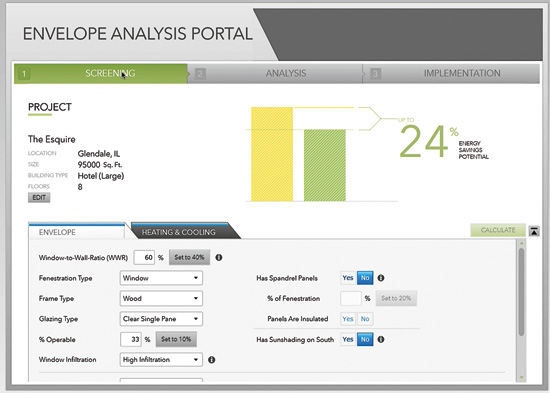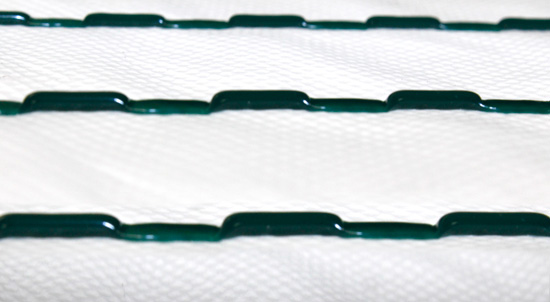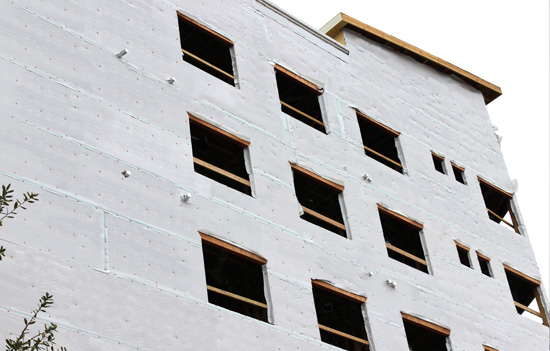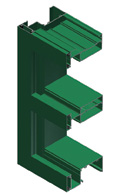Building Technologies Update for Multifamily Housing
Building Envelope Analysis
The envelope or exterior construction of all buildings directly impacts the energy performance and related energy costs. Therefore, conducting an analysis of a new or existing building envelope is one of the first and best steps a design team can take to understand how to achieve an energy-efficient and environmentally friendly building. This is especially important in the renovation of existing buildings, particularly if the building is being converted from some other use (i.e. warehouse, school, etc.) into multifamily housing that has become very popular in many areas. This analysis can be done in-house by architectural firms using available computer modeling software or by working with manufacturers who have customized software to analyze the options of different systems in a given building envelope system. Either way, a baseline building can be modeled, while the relative changes can be compared using specific envelope designs, types, and options.

Image courtesy of Pella EFCO Commercial Solutions
An envelope analysis using software applications, helps building teams to input a wide range of variables and conditions for existing or new buildings. This information can then be used to develop a strategy for potential energy savings.
One common and critically important component of building envelopes is fenestration. Hence, it is not surprising that some window manufacturers have embraced its importance and seek to partner with design professionals on conducting a building envelope analysis. Doug Phelps, Director of Commercial Business Development for Pella EFCO Commercial Solutions, points out that they work with designers on a “whole building analysis which is truly unique from the component approach. This way, we're able to analyze and run 'what-if' scenarios to compare potential envelope improvements in terms of energy savings, occupant comfort, and building aesthetics. Every project has specific goals, and we are able to support the project team with flexible, real-time analysis.” He also notes that this interest in full analysis came from occupants commenting that their spaces felt more comfortable after replacing windows. By adding the analysis of occupant comfort as part of the envelope analysis, it is also possible to quantify that improvement while showing projected energy savings for the building.
This process is available to any design team and supported by the national, independent energy engineering firm, The Weidt Group. According to David Eijadi, Principal in Charge of Energy for The Weidt Group, “The envelope analysis identifies potential problem areas and offers solutions to make buildings more energy-efficient and comfortable. In the process it leverages some of the best technology available in software for computing hourly energy simulations.”
Air and Water-Resistive Barriers (WRBs)
One significant part of a building envelope is its ability to be sealed completely. Hence, building codes require barriers be incorporated into envelope assemblies to prevent unwanted air infiltration and water penetration. Water-resistive barriers (WRBs) are commonly used that are synthetic, non-woven building wrap products. The high-performance advantages of this modern solution include a barrier that is more breathable, more durable, and more easily sealed along the seams. Further, this type of synthetic WRB can also double as a continuous exterior air barrier, meeting the code requirements for both in a single layer.
Using a high-performance building wrap in a multifamily housing project takes advantage of several innovative characteristics. First, as an engineered product, it creates a weather barrier behind exterior cladding to protect the sheathing and reduce water intrusion into wall cavities. This is important since all exterior cladding will likely allow some degree of water intrusion at some point. It is also particularly important in rainscreen assemblies where water is expected to enter behind a cladding material and is allowed to drain away. Second, as a vapor permeable or breathable product it will allow water or moisture to escape, thus allowing any damp or wet materials to dry in a relatively short amount of time. During this drying, WRBs can maintain their water resistance because they are constructed with pores that are large enough to allow moisture as a vapor to pass through but too small for water as a liquid to pass. Third, as an air barrier, a WRB will be an energy-efficient means to stop air infiltration and exfiltration through walls.


Images courtesy of Tamlyn
Strategically located spacers provide an intended drainage gap on synthetic, non-woven, breathable water-resistive barriers.
A further innovation has come about by enhancing building wraps to serve as an effective drainage plane set back from the cladding with a gap. The conventional means to create a drainage gap in a framed wall system is to use furring channels or strips. The alternative is to use a drainable WRB building wrap that provides its own integrated method of drainage. For example, at least one manufacturer creates this gap by bonding 1.5 mm propylene spacers to a high-performance WRB building wrap. This depth is large enough to provide a true drainage space between the sheathing and cladding material, allowing it to act as a full rainscreen system in miniature, without the added labor or cost. Further, it will work with all types of cladding systems, particularly those that can be moisture sensitive such as wood or fiber cement siding.
When specifying WRBs or building wraps for multifamily housing projects, it is important to recognize that there are literally dozens of building wrap products available with wide variations in performance and cost. They can also vary in water resistance, drainage efficiency, water vapor transmission or breathability, ability to impede air flow, durability, tear resistance, cold weather flexibility, flammability, and smoke developed ratings. Beyond that, however, it is important that the WRB can be sealed properly and fully along the seams without undue penetrations from staples or nails. Some manufacturers offer full sealing systems that avoid the use of nails and staples and instead use a compatible adhesive, sealant, or tape. Equally important are the details of how the WRB deals with openings in the wall such as doors and windows. Being able to flash and seal the WRB properly with window and door flashing materials will assure that water draining down the face of a drainable WRB will flow away properly and not behind other building elements into the wall.
Continuously Insulated Wall Systems
An innovative trend in multifamily housing projects has been the increased use of coordinated, high-performance wall systems with multiple components from a single manufacturer. According to John Cicciarelli of Oldcastle® Architectural National Masonry Sales, “Over the past few years, we've seen two innovations in multifamily housing projects: an increase in high-performance wall systems and an uptick in masonry veneers being specified.” In many cases, this system approach gives the designer the benefit of a total wall assembly that allows for better insulation solutions for increased energy efficiency. One such system uses a continuous insulating foam layer over a prepared substrate, typically in a framed wall, that is formed specifically to accept veneer stone or masonry products. In this way, it provides a full layer of continuous insulation outside of the framing while solving the common problem of how to best finish the exterior surface. The insulation in such systems can achieve thermal resistance R-values above R-13 and also provide an integrated moisture management design. The exterior finish can be selected from the wide range of veneer stone colors and patterns that are on the market or from the equally broad range of masonry and brick products. Of course, the finish stone or masonry products need to be selected to be compatible with the patterned insulation that is designed to receive them.

Image courtesy of Oldcastle® Architectural
In this exterior wall system there are three elements:
1) the patterned insulation panels are installed,
2) the corresponding, pre-selected stone or masonry veneer is installed, and
3) a specifically designed Type-S mortar is used to finish the surface and achieve the needed bond strength.
This type of wall system can be used on either new or existing buildings. In new construction, the framed wall assembly would need to be complete to the sheathing or substrate level with the appropriate air and water-resistive barrier in place as needed. In a renovation, existing cladding may be able to remain if it is fairly flat and intact. Otherwise it may need to be removed and the substrate adequately prepared. Then the installation of the formed foam insulation takes place using specially designed fasteners and screws. Next, the selected veneer stone or masonry is set into the formed openings of the insulation in a pre-selected pattern and held in place by friction between the foam panels and the manufactured teeth of the veneer. As in most veneer installations, anchors are used to affix the masonry and mortar to the substrate or structure of the building. The wall is finished using a Type-S mortar to assure proper bond strength, adhesion, flexibility, and stability. When finished, the wall is lighter in weight than a full masonry or stone wall, provides a full layer of continuous insulation, and offers a broad range of finished appearance choices. Further, the nature of the masonry and mortar makes the exterior surface more durable and longer lasting than some other cladding choices as well.
Notice

www.certainteed.com/gypsum

www.efcocorp.com

www.echelonmasonry.com

www.tamlynwrap.com









